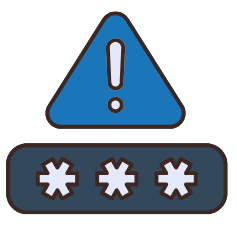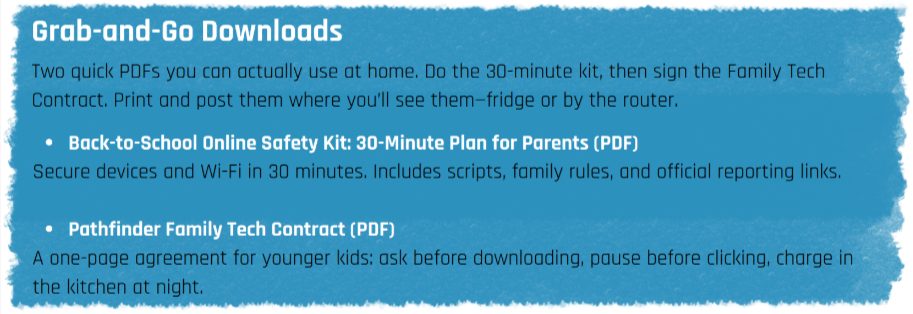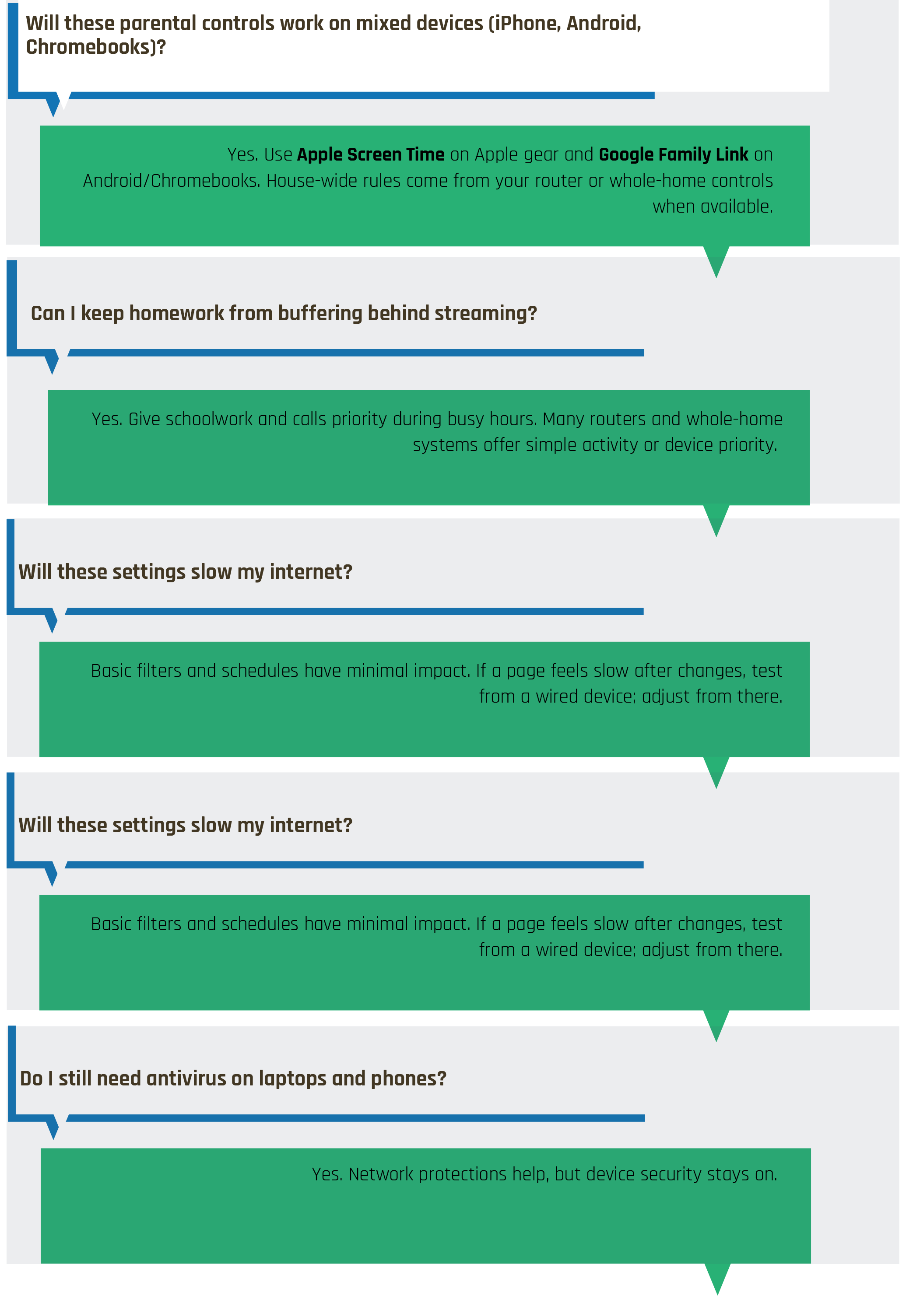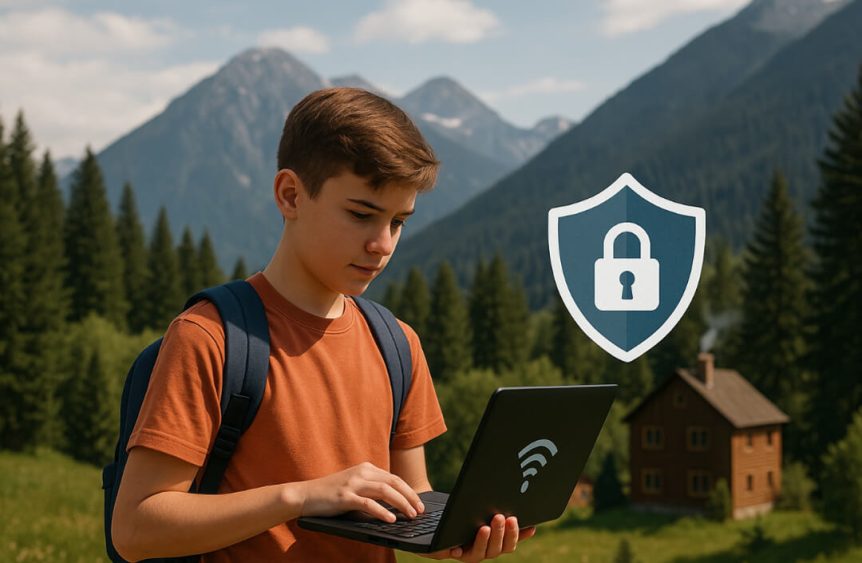My girls are 21 and 23 now. But not too long ago, they were stuffing notebooks in backpacks and rolling their eyes at my first-day photos. My feelings about back-to-school were a mixed bag, part “I’m glad school’s back,” part “Are they going to be okay with new teachers and friends? Are they safe at school?” After a major school shooting in 2018, I even stood in a store aisle looking at bullet-resistant backpacks, trying to decide what “prepared” meant for our family. I cried after drop-off, then went to work and hoped I’d made good choices.
Back then I watched the school doors. Later I learned to keep an eye on our home internet as well. If you live in our mountain communities, you know how much kids depend on home Wi-Fi once the bus drops them off. Out here, cell service can be hit or miss. Homework gets done at the kitchen table. Friends meet up in games and group chats. That’s why back-to-school internet safety belongs on the list with pencils and passwords. This post is a practical guide to kids’ online safety, home Wi-Fi security, and parental controls you can set up without a big overhaul.
You’ll also find two quick downloads you can actually use: a Back-to-School Online Safety Kit: 30-Minute Plan for Parents and a Pathfinder Family Tech Contract for younger kids. Start with the kit, post the contract on the fridge, and you’ll be ahead of most of us by the end of the week.
Make Your Home Wi-Fi School-Ready (Setup Checklist)
Here’s a quick back-to-school internet safety setup you can finish on a weeknight.
Phones and Laptops
 Update the OS and browsers. Out-of-date devices invite trouble.
Update the OS and browsers. Out-of-date devices invite trouble. Turn on multi-factor for school, email, and any banking a teen uses. Start with the email account; password resets live there.
Turn on multi-factor for school, email, and any banking a teen uses. Start with the email account; password resets live there. Create a separate “School” browser profile so classwork and YouTube aren’t fighting each other.
Create a separate “School” browser profile so classwork and YouTube aren’t fighting each other. Use a simple naming rule for accounts so you can spot fakes fast: Firstname.Lastname plus the school domain.
Use a simple naming rule for accounts so you can spot fakes fast: Firstname.Lastname plus the school domain. Run a quick link-check drill: show your child how to preview links—hover on a computer; press and hold on a phone. Practice with one real school email and one fake. Set the rule: if the address looks off, don’t open it. Screenshot and send it to you.
Run a quick link-check drill: show your child how to preview links—hover on a computer; press and hold on a phone. Practice with one real school email and one fake. Set the rule: if the address looks off, don’t open it. Screenshot and send it to you.
Consoles and game accounts

Set chat to friends-only. If your kid doesn’t know them in real life, they don’t need a mic.
 Require a purchase PIN on Xbox, PlayStation, and Nintendo.
Require a purchase PIN on Xbox, PlayStation, and Nintendo. Pick play windows that match bedtime and practice. Set it once and be done.
Pick play windows that match bedtime and practice. Set it once and be done.
Home Wi-Fi security

Change the admin password and save it where both parents can find it.
 Turn on automatic firmware updates.
Turn on automatic firmware updates. Create a guest network for friends and visitors; keep family devices on the main network.
Create a guest network for friends and visitors; keep family devices on the main network. Check if your router offers web filtering. Most systems include schedules and a pause button by default; filtering is sometimes an add-on. If your setup includes it, turn on broad categories (malware, phishing, adult sites).
Check if your router offers web filtering. Most systems include schedules and a pause button by default; filtering is sometimes an add-on. If your setup includes it, turn on broad categories (malware, phishing, adult sites). Name devices in the router list so you recognize what’s online at a glance.
Name devices in the router list so you recognize what’s online at a glance.
House rules that actually stick
 Phones charge in one spot overnight, not in bedrooms.
Phones charge in one spot overnight, not in bedrooms. If a message feels urgent or promises free rewards, pause and ask.
If a message feels urgent or promises free rewards, pause and ask. If someone is unkind online, show a parent first. No replies in the heat of the moment.
If someone is unkind online, show a parent first. No replies in the heat of the moment.
Next, add simple parental controls that work on the gear you already have, then talk about network features that make the whole house easier to manage.
Home Wi-Fi Parental Controls and Security for Families
Device settings are a good start. What really helps, especially in busy houses, is moving a few controls to the network so every phone, laptop, and console follows the same rules.
Profiles by person
Create a profile for each kid and link their devices to it. Now when you set a rule, it follows them, not just one device.
- Elementary: school-night bedtime, no new apps without a parent.
- Middle: homework window, friends-only chat, downloads need a check.
- High school: fewer hard stops, more “you decide, then we review.”

Screen-time schedules and bedtimes
Set a start and stop time for school nights. Add a short “wind-down” period before lights out. It removes the nightly debate.

Content filtering that’s not a headache
Turn on basic web filtering at the household level when it’s available. Start with broad categories like adult sites, obvious scam domains, and malware. Keep it light and review it once a month. If your provider offers whole-home controls in the app, you can manage it all in one place.

A pause button that actually works

Priority for the things that can’t buffer

Threat blocking at the edge

Coverage for long driveways and metal buildings
Big houses and metal siding weaken Wi-Fi fast. Check the spots you actually use (kitchen, kids’ rooms, shop); if pages crawl or bars drop, try this:
- Put the main router high and central, not in a cabinet.
- Add a mesh node near the weak area; avoid plug-in “extenders” if you can.
- For a shop or barn with metal walls, plan a separate access point in that building.
If you want help turning any of these on across the whole house, reach out to Pathfinder. We’ll check your layout, help with defaults, and, if you want, add services for coverage or security.
What To Say to Your Kids About Online Safety (By Age)
You don’t need a long lecture. Give them a few lines they can remember and practice once.

Elementary
“If you didn’t expect the link, don’t open it. Bring it to me.”

Middle school
“Urgent messages and free rewards are tricks. Pause and text me a screenshot.”
“Join group chats where you know at least one person in real life.”
“If someone is unkind online, show me before you reply. We’ll handle it together.”

High school
“If a message asks for money or personal info, even from a friend, verify on a different app.”
“Search your name with your school. That’s what a coach or college sees.”
“If a feed makes you angry at everyone, that’s a sign to step back. Let’s talk about it.”
If Something Goes Wrong Online: First Steps
Clicked a bad link or download
- Stop using the device.
- Change the password for the account involved.
- If that password was reused anywhere else, change it there too.
- Turn on multi-factor if it isn’t already.
- Run a full system update and the built-in malware scan.
- If it touched a school account, let the school know.

“Your account is locked” or strange login alerts
- Don’t click links in the alert. Go to the site directly and sign in.
- If you can’t sign in, start the official password reset.
- Check recent activity and sign out of other sessions.
- Turn on multi-factor.
- Tell your kid to forward future alerts to you before acting.

Cyberbullying or a group-chat pile-on
- Save screenshots with dates.
- Block or mute the account.
- Report inside the app.
- Follow your school’s reporting steps.
- Keep devices available so your kid isn’t afraid to ask for help.

Lost or stolen phone
- Use Find My iPhone or Find My Device to locate or mark it lost.
- Change the Apple ID or Google password.
- Call your carrier to suspend service if needed.
- When you replace the phone, restore from backup and re-enable multi-factor.

Money requests and “help me buy gift cards”
- Assume it’s a scam, even if it looks like a friend.
- Verify on a different channel before sending money or codes.
- Tell your kid: no wires, no crypto, no gift cards. Ever.


Tip
Do the kit first, then sign the contract. Revisit both once a month.
FAQs for Mountain Homes

When to call Pathfinder
- You want house-wide parental controls that apply to every device
- You need better coverage for a large home, shop, or barn
- You’d like simple threat blocking with clear alerts, not a dozen apps
We live here too. Tell us what isn’t working, and we’ll help you sort it out without a lot of fuss.
A Simple Plan Goes a Long Way
Those first-day jitters never fully leave. I watched the school doors when my girls were little. Now I watch our home Wi-Fi and the habits that go with it. A few parental controls, a couple of house rules, and a plan you can stick to will cover most of what matters. If you want a hand, Pathfinder’s close by.

